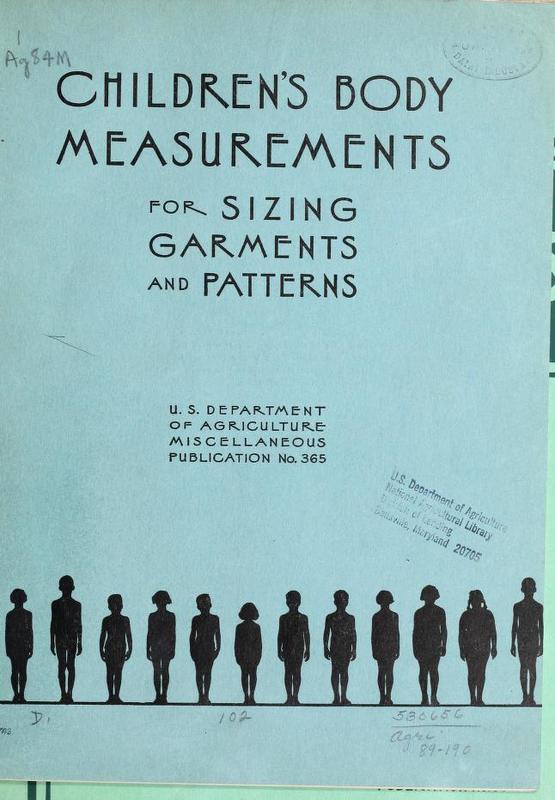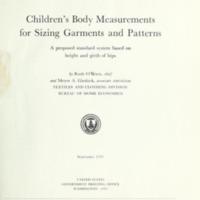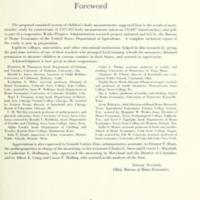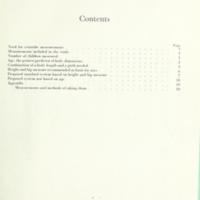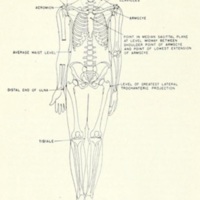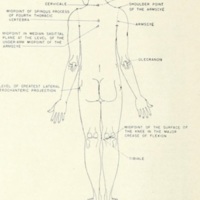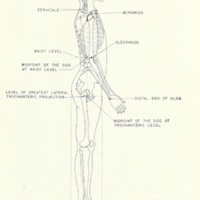Children's Body Measurements for Sizing Garments and Patterns: A Proposed Standard System Based on Height and Girth of Hips
Title
Children's Body Measurements for Sizing Garments and Patterns: A Proposed Standard System Based on Height and Girth of Hips
Date
1939
Relation
U.S. Department of Agriculture Miscellaneous Publication Number 365
Subject
Excerpt
Need for Scientific Measurements
The rapid growth of the pattern and ready-to- wear industry in the United States has brought with it many difficulties in the proper sizing of garments and patterns, especially those manufactured for women and children. Any satisfactory American sizing system must be based on dimensions obtained by measuring large numbers of persons throughout the country. Each measurement must be made in exactly the same way by individuals carefully trained in a method that can be duplicated. The same kind of instruments must be used, and these must be constantly checked so that they are accurate.
Unfortunately no such large, scientific study of the body measurements used in the construction of women's and children's garments has ever been reported. When funds were made available by the Works Progress Administration in 1937, the Bureau of Home Economics, therefore, organized and directed such a cooperative research project. The measurements used in the construction of trunk garments were taken on 147,088 children, 4 to 17 years of age, inclusive, distributed in 15 States and the District of Columbia.
This proposed standard of body measurements is based on the results of that study. It recommends dimensions to be used in constructing a series of standard mannequins such as are used by manufacturers to size garments and patterns. The measurements were taken next to the skin. The proposed standard, therefore, does not give garment and pattern dimensions. Standards for these can be developed from this proposed basis by agreement in the trade on tolerances for construction, style, and other clothing features.
The rapid growth of the pattern and ready-to- wear industry in the United States has brought with it many difficulties in the proper sizing of garments and patterns, especially those manufactured for women and children. Any satisfactory American sizing system must be based on dimensions obtained by measuring large numbers of persons throughout the country. Each measurement must be made in exactly the same way by individuals carefully trained in a method that can be duplicated. The same kind of instruments must be used, and these must be constantly checked so that they are accurate.
Unfortunately no such large, scientific study of the body measurements used in the construction of women's and children's garments has ever been reported. When funds were made available by the Works Progress Administration in 1937, the Bureau of Home Economics, therefore, organized and directed such a cooperative research project. The measurements used in the construction of trunk garments were taken on 147,088 children, 4 to 17 years of age, inclusive, distributed in 15 States and the District of Columbia.
This proposed standard of body measurements is based on the results of that study. It recommends dimensions to be used in constructing a series of standard mannequins such as are used by manufacturers to size garments and patterns. The measurements were taken next to the skin. The proposed standard, therefore, does not give garment and pattern dimensions. Standards for these can be developed from this proposed basis by agreement in the trade on tolerances for construction, style, and other clothing features.
File(s)
Children\'s Body Measurements Cover.jpg
(image/jpeg)
Children\'s Body Measurements Title.jpg
(image/jpeg)
Children\'s Body Measurements Foreward.jpg
(image/jpeg)
Children\'s Body Measurements TOC.jpg
(image/jpeg)
Children\'s Body Measurements Appendix.jpg
(image/jpeg)
Children\'s Body Measurements Body Landmarks 1.jpg
(image/jpeg)
Children\'s Body Measurements Body Landmarks 2.jpg
(image/jpeg)
Children\'s Body Measurements Body Landmarks 3.jpg
(image/jpeg)
 An official website of the United States government.
An official website of the United States government.


